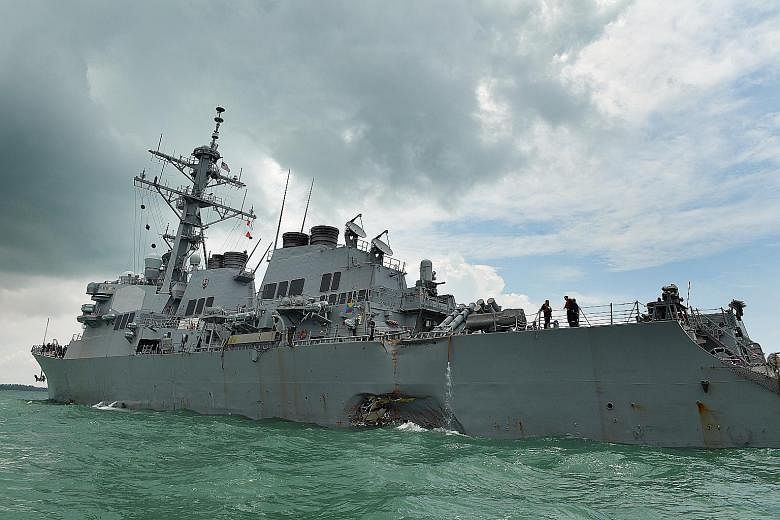The full findings of Singapore's investigations into the Aug 21 collision of an oil tanker and a United States warship will be made public once it is ready - a process that typically takes up to 12 months.
Responding to media queries yesterday, Singapore's Transport Safety Investigation Bureau (TSIB) said that it is looking into all circumstances leading up to the collision, which claimed the lives of 10 American sailors on board the USS John S. McCain.
The bureau is a unit within the Ministry of Transport which investigates air and sea accidents.
To date, it has conducted interviews and obtained information from the Liberian-registered tanker, Alnic MC, and its crew, as well as ships in the vicinity during the collision. It is also working with the US Coast Guard to obtain relevant information from the US warship.
The bureau added that it has reviewed the recordings of the Maritime and Port Authority's (MPA) Vessel Traffic Information System (VTIS), which tracks vessels via radar or the Automatic Identification System (AIS) signals, and enables an alert to be sent to vessels in the event of an impending collision and to get them to change course.
The AIS reveals critical information - like a ship's location, identity, speed and direction of travel - to other vessels in the area and monitoring stations.
The bureau said it established that the MPA's VTIS "held" both vessels on MPA's radar.
But while the VTIS also received Alnic MC's AIS signal, it did not receive any AIS signal from the US warship.
The bureau added that under the International Convention for the Safety of Life at Sea, the mandatory carriage of AIS does not apply to ships of war and troop ships.
Soon after the Aug 21 incident, MPA had said that its systems had detected only the oil tanker and not the US warship.
TSIB did not elaborate, but naval experts told The Straits Times that while it is almost impossible for military warships to operate completely in stealth mode at sea, these warships can take steps to weaken radar or sonar detection.
This includes absorbent paint and surfaces angled to reflect signals elsewhere.
In the case of the USS John S. McCain, it is likely that MPA detected only a blip on its VTIS, signalling that something was there.
But without AIS confirmation, MPA was not able to ascertain that the blip was the US warship.
Explained a former Singapore naval officer: "With stealth technology, you can be a huge warship but appear on radar screens as a sampan. The whole point is to move under a cloak of secrecy."
The Arleigh Burke-class destroyer, which has been berthed at Changi Naval Base since the accident, will leave Singapore for Yokosuka, Japan, some time next month, said a spokesman for the US Seventh Fleet. The vessel, which needs further repairs, will be carried by a heavy lift vessel, he said.
Many of the crew members have been here since the collision, assisting with ongoing technical assessments of the damage as well as transit preparations such as placing systems in lay-up maintenance, he added.
The collision - the fourth incident in Asia involving a US warship this year - has raised questions about the US Navy's operations and procedures.
In an appearance before the US Senate Armed Services Committee last week, Chief of Naval Operations John Richardson said that while the US Navy has for years had AIS on board, the system was rarely used. He said: "One of the immediate actions following these incidents - particularly in heavily trafficked areas - (is that) we're just going to turn it on."
The Aug 21 collision occurred in Singapore territorial waters near Pedra Branca - situated at the eastern entrance to the Singapore Strait - but Malaysia had claimed the incident took place in its waters.
The International Court of Justice (ICJ) had in a 2008 judgment awarded sovereignty over Pedra Branca to Singapore and neighbouring Middle Rocks to Malaysia.
But in June, Malaysia filed an application at the ICJ to declare that the waters around Pedra Branca are within its territorial waters.
Singapore has said that it will oppose the bid, which it called unnecessary and without merit.


